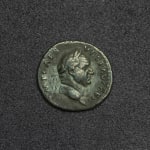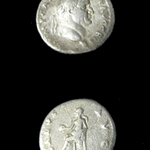Silver Denarius of Emperor Vespasian, 69 CE - 79 CE
Silver
2.7 Grams
LC.133
Further images
Obverse | Lateral portrait of Roman Emperor Vespasian wearing a laurel wreath. Inscription | IMP CAES VESP AVG CEN Reverse | Salus, the Roman goddess of safety and well-being, seated...
Obverse | Lateral portrait of Roman Emperor Vespasian wearing a laurel wreath.
Inscription | IMP CAES VESP AVG CEN
Reverse | Salus, the Roman goddess of safety and well-being, seated on a throne with a patera and a serpent.
Inscription | SALVS AVG
Vespasian was a Roman emperor who reigned from 69 to 79 AD and founded the Flavian dynasty, which ruled the empire for 27 years. Vespasian is widely credited with laying the groundwork for the Pax Romana, the golden age of the 2nd century CE. This was achieved by ending the civil war that had plagued the Roman Empire and restoring financial stability after the oppressive rule of Emperor Nero. Vespasian initiated the construction of the Amphitheatrum Flavium, also known as the Colosseum. Issued during the reign of Emperor Vespasian, the obverse of this silver coin shows a side portrait of the Roman Emperor Vespasian with a laurel wreath and the title "IMPerator CAESar VESPASIANUS AVGustus CENsor" or Supreme Commander, Emperor Vespasian, Augustus, Censor of the Roman People. On the reverse of the coin, Salus, the Roman goddess of safety and well-being, is seated on a throne holding a patera and a sacred snake. The inscription "SALVS AVGusti" accompanies the image, wishing the emperor good health.
Inscription | IMP CAES VESP AVG CEN
Reverse | Salus, the Roman goddess of safety and well-being, seated on a throne with a patera and a serpent.
Inscription | SALVS AVG
Vespasian was a Roman emperor who reigned from 69 to 79 AD and founded the Flavian dynasty, which ruled the empire for 27 years. Vespasian is widely credited with laying the groundwork for the Pax Romana, the golden age of the 2nd century CE. This was achieved by ending the civil war that had plagued the Roman Empire and restoring financial stability after the oppressive rule of Emperor Nero. Vespasian initiated the construction of the Amphitheatrum Flavium, also known as the Colosseum. Issued during the reign of Emperor Vespasian, the obverse of this silver coin shows a side portrait of the Roman Emperor Vespasian with a laurel wreath and the title "IMPerator CAESar VESPASIANUS AVGustus CENsor" or Supreme Commander, Emperor Vespasian, Augustus, Censor of the Roman People. On the reverse of the coin, Salus, the Roman goddess of safety and well-being, is seated on a throne holding a patera and a sacred snake. The inscription "SALVS AVGusti" accompanies the image, wishing the emperor good health.





